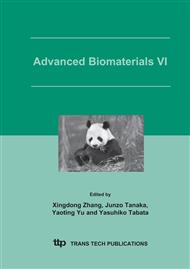p.637
p.641
p.645
p.649
p.653
p.657
p.661
p.665
p.669
3D Finite Element Analysis of Bone Stress around Distally Osteointegrated Implant for Artificial Limb Attachment
Abstract:
Stress shielding, which occurred always around traditional one part implant applied for prosthetic artificial lower limb attachment, would cause osteoporosis and thus result in the loose and extrusion, and then the malfunction of the implant. To improve the structure of the implant, a new type of implant—multi-part implant was developed in this article. Based on CT data and under the maximal load during a normal walking cycle, 3D finite element analysis (FEA) was carried out to analyze the stress of bone around the new implant in three cases of distally truncated femur at high position、middle-position and low-position. Results reveal that stress shielding and stress concentration under the new type of implant reduced effectively compared with the traditional one-part implant, and the stress distribution is much close to the natural bone. Application for distally truncated femur at middle-position and low-position was much better, while stress concentration was marked at high-position. Meanwhile, the stability in vivo can also be maintained with the multi-part implant. The new implant is promising applied for prosthetic limb.
Info:
Periodical:
Pages:
653-656
Citation:
Online since:
June 2005
Authors:
Keywords:
Price:
Сopyright:
© 2005 Trans Tech Publications Ltd. All Rights Reserved
Share:
Citation:


